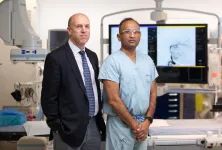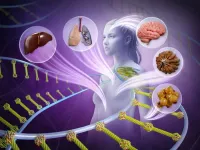(Press-News.org) Research Highlights:
Neither a placebo procedure nor two different doses of transcranial brain stimulation, which send electrical signals through the skull, improved mobility recovery in stroke survivors receiving movement therapy.
Motor function was similar among survivors who received electrical brain stimulation combined with movement therapy or a placebo combined with movement therapy.
Note: The study featured in this news release is a research abstract. Abstracts presented at the American Heart Association’s scientific meetings are not peer-reviewed, and the findings are considered preliminary until published as full manuscripts in a peer-reviewed scientific journal.
Embargoed until 11:30 a.m. PT/2:30 p.m. ET Thursday, Feb. 6, 2025
LOS ANGELES, Feb. 6, 2025 — Mild electrical brain stimulation did not further improve motor recovery in stroke survivors, according to late-breaking science presented today at the American Stroke Association’s International Stroke Conference 2025. The conference, in Los Angeles, Feb. 5-7, 2025, is a world premier meeting for researchers and clinicians dedicated to the science of stroke and brain health.
“The results are somewhat surprising to us,” said study leading-principal investigator Wayne Feng, M.D., M.S., professor of neurology and biomedical engineering at Duke University School of Medicine in Durham, North Carolina. “We initially hoped that a higher dose at 4 milliamps electrical stimulation had a better effect than a lower dose as well as the sham group, but we did not see that.”
In the United States, stroke is the fifth leading cause of death and a leading cause of long-term disability, according to the American Heart Association’s Heart Disease and Stroke Statistics 2025 Update, released last week. Depending on the part of the brain affected, stroke may impair arm and/or leg movement and activities of daily life among survivors. Motor impairment (arm and/or leg weakness) is the most common complication after stroke.
Constraint-induced movement therapy (CIMT) restricts movement on the unaffected arm (by wearing a mitt over a hand) to force the use of the stroke-affected side. This therapy has been shown to improve motor function and quality of life in certain stroke patients with preserved hand movement. However, it requires intensive treatment. For example, the traditional format requires six hours per day and a modified treatment format requires two hours per session in the clinic, five days per week, with additional homework after the clinical session. This can be challenging for stroke survivors, Feng said.
Researchers studied whether transcranial direct current stimulation could enhance the effects of constraint-induced movement therapy, allowing for better use of the arm affected by the stroke. In this study, a weak electrical current — up to 4 milliamps (4 one thousandth of an ampere) powered by a 9-volt battery — was delivered through the skull.
The study, TRANScranial direct current stimulation for POst-stroke motor Recovery — a phase II sTudy (TRANSPORT 2), is the first funded multi-center stroke recovery study on the National Institutes of Health (NIH) StrokeNet, a network of U.S. regional centers and hospitals conducting major stroke-related clinical trials focusing on acute treatment, prevention and recovery. Researchers assessed three aspects of arm function (impairment, function and quality of life) after 10 sessions over the two-week period using three doses of electrical stimulation — sham/placebo stimulation, low dose (2 milliamps) and higher dose (4 milliamps or mA) — on 129 stroke survivors undergoing constraint-induced movement therapy in major medical centers across the U.S. The stimulation was 30 minutes and the CIMT therapy was 120 minutes each session.
The analysis found:
Transcranial direct current stimulation up to 4mA did not amplify the effect of constraint-induced movement therapy.
The stroke survivors in all three groups improved after two weeks of treatment, and the effect continued at one month and three months after the intervention; however, the magnitude of improvement among the three groups was similar.
The stimulation is safe and tolerable in stroke patients. The combined intervention was feasible to implement in the multi-center clinical trial setting.
A limitation of the study is the trend of uneven representation of women in each group considering that women may respond differently than men to brain stimulation. Another limitation is that the study was interrupted by the COVID-19 pandemic, which slowed enrollment and scoring issues on the primary outcomes.
“In future clinical trials, we plan to enhance our approach by implementing several improvements,” Feng said. “These improvements will include using a higher dose – more than 4 milliamps, ensuring men and women are equally distributed in each group and ensuring consistent administration and scoring the primary outcomes across all clinical trial sites. It may take us a few attempts before we achieve success.”
Study design, background and details:
Study participants were first-ever ischemic (clot-caused) stroke survivors who suffered a stroke one to six months earlier and had persistent arm weakness but still had slight movement of the hand.
The study included 129 stroke survivors with an average age of 59 years. 42% were women, 53% were white adults, 41% were Black adults, 3% were Asian population and about 2% said they were multiple races. Participants were randomly assigned to one of three doses of brain stimulation.
It was conducted between September 2019 and September 2024 in 15 U.S. medical centers in 11 U.S. states and the District of Columbia. Each person participated in the study for about four months.
Clinical outcome was assessed using the Fugl-Myer Upper-Extremity Scale (measuring motor impairment), Wolf Motor Functional Test (measuring motor function) and the Stroke Impact Scale Hand Subscale (measuring quality of life).
All clinical outcomes were assessed immediately after two weeks of intervention, and again one month and three months after the initial intervention.
Researchers found the combined brain stimulation and intensive rehabilitation therapy was safe, tolerable and feasible.
Feng led the study with co-principal investigator Gottfried Schlaug, M.D., Ph.D., FAHA., vice-chair for Research at University of Massachusetts Chan Medical School – Baystate in Springfield. Additional study co-authors, funding and disclosures are available in the abstract.
Statements and conclusions of studies that are presented at the American Heart Association’s scientific meetings are solely those of the study authors and do not necessarily reflect the Association’s policy or position. The Association makes no representation or guarantee as to their accuracy or reliability. Abstracts presented at the Association’s scientific meetings are not peer-reviewed, rather, they are curated by independent review panels and are considered based on the potential to add to the diversity of scientific issues and views discussed at the meeting. The findings are considered preliminary until published as a full manuscript in a peer-reviewed scientific journal.
The Association receives funding primarily from individuals; foundations and corporations (including pharmaceutical, device manufacturers and other companies) also make donations and fund specific Association programs and events. The Association has strict policies to prevent these relationships from influencing the science content. Revenues from pharmaceutical and biotech companies, device manufacturers and health insurance providers and the Association’s overall financial information are available here.
Additional Resources:
Multimedia is available on the right column of release link.
Link to abstract LB 16 and the ASA International Stroke Conference 2025 Online Program Planner
AHA/ASA health information: Recovery After Stroke
AHA news release: Nerve stimulation plus intense rehab may improve arm and hand function after stroke (Feb. 2024)
AHA news release: Wearable brain stimulation could safely improve motor function after stroke (Feb. 2020)
For more news at ASA International Stroke Conference 2025, follow us on X @HeartNews #ISC25
About the American Stroke Association
The American Stroke Association is devoted to saving people from stroke — the No. 2 cause of death in the world and a leading cause of serious disability. We team with millions of volunteers to fund innovative research, fight for stronger public health policies and provide lifesaving tools and information to prevent and treat stroke. The Dallas-based association officially launched in 1998 as a division of the American Heart Association. To learn more or to get involved, call 1-888-4STROKE or visit stroke.org. Follow us on Facebook, X.
###
END
Brain stimulation did not improve impaired motor skills after stroke
American Stroke Association International Stroke Conference – Late-Breaking Science Presentation LB 16
2025-02-06
ELSE PRESS RELEASES FROM THIS DATE:
Some species of baleen whales avoid attracting killer whales by singing too low to be heard
2025-02-06
Killer whales are the only natural predator of baleen whales — those that have “baleen” in their mouths to sieve their plankton diet from the water. More solitary than toothed whales, baleen whales face predatory attacks from killer whales, especially mother and calf pairs. When attacked, some species fight back, while others choose flight.
But whale species also produce loud underwater songs. What stops killer whales from homing in on their calls and attacking them?
New research from the University of Washington finds some baleen whale species call at such deep frequencies that they’re completely undetectable ...
Wasteful tests before surgery: Study shows how to reduce them safely
2025-02-06
For many patients, getting ready to have surgery means getting their blood drawn, their heart rhythm checked, or having other tests in the weeks leading up to their operation.
But not all patients need all those tests -- especially if the results won’t change how their surgical team treats them or how well they do afterward.
Now, a new study shows how hospitals can focus the use of such tests on the patients who truly need them, while safely reducing unnecessary testing in others.
The result: less wasted money and resources for each test, and less wasted time for patients and clinical staff.
The study, published in JAMA ...
UCalgary researchers confirm best approach for stroke in medium-sized blood vessels
2025-02-06
University of Calgary’s Hotchkiss Brain Institute researchers with the Calgary Stroke Program at Foothills Medical Centre revolutionized treatment for stroke with the ESCAPE Trial, proving that a clot retrieval procedure known as endovascular thrombectomy (EVT) can dramatically improve patient outcomes after an acute ischemic stroke caused by a blockage in a large-sized blood vessel.
Building on that knowledge, the team launched the ESCAPE-MeVO clinical trial to assess whether ischemic stroke patients with blockages in smaller medium-sized vessels could also benefit from EVT. Ischemic strokes are the most common form of stroke. The study, published ...
Nationwide, 34 local schools win NFL PLAY 60 grants to help students move more
2025-02-06
DALLAS, Feb. 6, 2025 — Physical activity positively impacts overall mental and physical wellness which is essential to help children reach their full potential[1]. That is why the American Heart Association, committed to changing the future of health, and the National Football League (NFL) are awarding 34 schools, at least one for each of the NFL teams, with $1,000 grants for physical activity equipment. Through support from the NFL, the NFL PLAY 60 grants are distributed by the American Heart Association annually to recognize those classrooms and ...
New software developed at Wayne State University will help study chemical and biological systems
2025-02-06
DETROIT — Physics-based computer simulations are essential tools for understanding the relationship between atomic-level interactions and physically observable properties of materials. It is from knowledge of these structure-property relationships that new materials can be designed with properties specifically tailored to address the problem of interest.
With the help of a new grant from the National Science Foundation (NSF), a team of Wayne State University College of Engineering researchers are developing new software to support computational materials design. Built on a 15-year collaborative effort, Jeffrey Potoff, Ph.D., chair ...
uOttawa study unveils new insights into how neural stem cells are activated in the adult human brain
2025-02-06
A University of Ottawa neuroscientist has led a Canadian research team to reveal important new insights into the activation dynamics of neural stem cells (NSCs). These are the stem cells that build our central nervous systems and the self-renewing.
The collaborative team led by the University of Ottawa’s Dr. Armen Saghatelyan aimed to shed light on how neural stem cells integrate a multitude of signals from different cell types in the brain – and how they decode these signals.
These are big questions because how NSCs react to signals in their cellular environment controls whether they remain in their ...
Cystic fibrosis damages the immune system early on
2025-02-06
Despite new medication, cystic fibrosis often leads to permanent lung damage. Working with an international team, researchers from the Technical University of Munich (TUM) have discovered that the disease causes changes in the immune system early in life, presumably even in newborns. These changes lead to frequent inflammation and are not affected by drugs targeting the altered mucus production.
Cystic fibrosis is caused by hereditary genetic mutations that impair or halt the production of the CFTR protein. The respiratory tract ...
Novel ‘living’ biomaterial aims to advance regenerative medicine
2025-02-06
UNIVERSITY PARK, Pa. — A biomaterial that can mimic certain behaviors within biological tissues could advance regenerative medicine, disease modeling, soft robotics and more, according to researchers at Penn State.
Materials created up to this point to mimic tissues and extracellular matrices (ECMs) — the body’s biological scaffolding of proteins and molecules that surrounds and supports tissues and cells — have all had limitations that hamper their practical applications, according to the team. To overcome some of those limitations, ...
Warding off superbugs with a pinch of turmeric
2025-02-06
In 2017, a tragic incident unfolded in a Nevada hospital. A woman, admitted for pneumonia, tragically succumbed to multiple organ failure and sepsis. The culprit? A strain of bacteria that had developed resistance to a staggering 26 different antibiotics. These superbugs, or antibiotic-resistant bacteria, stand as one of the most pressing public health threats globally.
Joining the effort to fight these deadly pathogens, researchers at Texas A&M have now shown that curcumin, the compound that gives turmeric its characteristic bright yellow color, can potentially be used to reduce antibiotic resistance.
The ...
Ophthalmic complications in patients on antidiabetic GLP-1 medications are concerning neuro-ophthalmologists
2025-02-06
BUFFALO, N.Y. — A small percentage of patients taking the extraordinarily popular GLP-1 medications have experienced vision problems, but a direct causal link with the drugs has not been established. That is the conclusion of a retrospective study published online on Jan. 30 in JAMA Ophthalmology.
The study focused on nine patients who had experienced vision problems while using semaglutide (brand names Wegovy and Ozempic) and tirzepatide (brand names Mounjaro and Zepbound).
The paper is one of several in the past ...
LAST 30 PRESS RELEASES:
Scalable and healable gradient textiles for multi‑scenario radiative cooling via bicomponent blow spinning
Research shows informed traders never let a good climate crisis go to waste
Intelligent XGBoost framework enhances asphalt pavement skid resistance assessment
Dual-function biomaterials for postoperative osteosarcoma: Tumor suppression and bone regeneration
New framework reveals where transport emissions concentrate in Singapore
NTP-enhanced lattice oxygen activation in Ce-Co catalysts for low-temperature soot combustion
Synergistic interface engineering in Cu-Zn-Ce catalysts for efficient CO2 hydrogenation to methanol
COVID-19 leaves a lasting mark on the human brain
Scientists use ultrasound to soften and treat cancer tumors without damaging healthy tissue
Community swimming program for Black youth boosts skills, sense of belonging, study finds
Specific depressive symptoms in midlife linked to increased dementia risk
An ‘illuminating’ design sheds light on cholesterol
Who is more likely to get long COVID?
Study showcases resilience and rapid growth of “living rocks”
Naval Research Lab diver earns Office of Naval Research 2025 Sailor of the Year
New Mayo-led study establishes practical definition for rapidly progressive dementia
Fossil fuel industry’s “climate false solutions” reinforce its power and aggravate environmental injustice
Researchers reveal bias in a widely used measure of algorithm performance
Alcohol causes cancer. A study from IOCB Prague confirms damage to DNA and shows how cells defend against it
Hidden viruses in wastewater treatment may shape public health risks, study finds
Unlock the power of nature: how biomass can transform climate mitigation
Biochar reshapes hidden soil microbes that capture carbon dioxide in farmland
Reducing saturated fat intake shows mortality benefit, but only in high-risk individuals
Manta rays create mobile ecosystems, study finds
Study: Mixed results in using lipoic acid to treat progressive multiple sclerosis
Norbert Holtkamp appointed director of Fermi National Accelerator Laboratory
New agentic AI platform accelerates advanced optics design
Biologists discover neurons use physical signals — not electricity — to stabilize communication
Researchers discover that a hormone can access the brain by hitchhiking
University of Oklahoma researcher awarded funding to pursue AI-powered material design
[Press-News.org] Brain stimulation did not improve impaired motor skills after strokeAmerican Stroke Association International Stroke Conference – Late-Breaking Science Presentation LB 16


